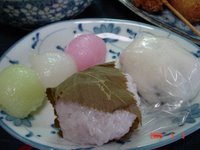 Today is Hinamatsuri (Girl's Day). In Japan, they also call it momo-no-sekku (peach blossom festival). When a girl is born, her parents or grandparents buy an elaborate set of hina dolls (Girl's Day dolls) unless they are passing their own set down to her.
Today is Hinamatsuri (Girl's Day). In Japan, they also call it momo-no-sekku (peach blossom festival). When a girl is born, her parents or grandparents buy an elaborate set of hina dolls (Girl's Day dolls) unless they are passing their own set down to her.The hina dolls are dressed in traditional kimono (wear) and are displayed on a terraced stand that is covered with red carpet. Peach blossoms, shiro-zake (white rice wine) and hishi-mochi (diamond shaped rice cakes) are also placed on the stand with the hina dolls. The hishi-mochi are colored pink, white and green. Pink represents the peach flowers, white represents snow of winter and green represents the new green that will come with spring. The dolls are displayed from the end of February until March 3rd. It is believed that the dolls should be taken down soon after the festival otherwide the daughter's marriage may be delayed. It is a day which the family prays for the happiness and health of their daughter.
 There are some foods that are eaten on this day. One is chirashi-zushi (rice seasoned with vinegar and sugar with a variety of colorful toppings). Another is sakura mochi (a rice cake flavored with sakura (cherry blossoms)), inside is an (sweet bean paste) and it is wrapped with a salted sakura leaf which can also be eaten).
There are some foods that are eaten on this day. One is chirashi-zushi (rice seasoned with vinegar and sugar with a variety of colorful toppings). Another is sakura mochi (a rice cake flavored with sakura (cherry blossoms)), inside is an (sweet bean paste) and it is wrapped with a salted sakura leaf which can also be eaten). Today, for breakfast we had chirashizushi, assorted Japanese sweets (hanamidango or san-shoku-dango (tri-colored mochi on a skewer usually seen at hanami (cherry blossom viewing)), sakura mochi, and manju (steamed black bean bun) , kushi-katsu (deep fried kisu (sillago), uzura tamago (boiled quail eggs) and bacon wrapped asparagus on a skewer) and green tea.
Today, for breakfast we had chirashizushi, assorted Japanese sweets (hanamidango or san-shoku-dango (tri-colored mochi on a skewer usually seen at hanami (cherry blossom viewing)), sakura mochi, and manju (steamed black bean bun) , kushi-katsu (deep fried kisu (sillago), uzura tamago (boiled quail eggs) and bacon wrapped asparagus on a skewer) and green tea. In 2002, I was fortunate to be able to see an elaborate display of hinaningyo (Girl's day dolls). Instead of the usual tiered stand, this display was housed in a real doll house! The owner, Ms. Hosoda, dressed each doll herself and decorated the doll house too. This household follows the Lunar calendar, so her display is usually put up in April. Her home was over 400 years old and sat on over 2 acres of land (very rare in Japan!) It was an excellent opportunity. This is a photo of the display.
In 2002, I was fortunate to be able to see an elaborate display of hinaningyo (Girl's day dolls). Instead of the usual tiered stand, this display was housed in a real doll house! The owner, Ms. Hosoda, dressed each doll herself and decorated the doll house too. This household follows the Lunar calendar, so her display is usually put up in April. Her home was over 400 years old and sat on over 2 acres of land (very rare in Japan!) It was an excellent opportunity. This is a photo of the display. Since I haven't seen many ume (plum) blossoms or momo (peach) blossoms yet, I'm using photos that I took in 2002. This one was from the Osaka castle's peach grove.
Since I haven't seen many ume (plum) blossoms or momo (peach) blossoms yet, I'm using photos that I took in 2002. This one was from the Osaka castle's peach grove.Chirashizushi is quite tedious to make, if you can find a ready-made mix (like I did), it will definitely save you some time. But, if you want to try to make this from scratch, I'll attach the recipe:
Chirashizushi from Orange Page #8: Serves 4
3 cups of rice (540 cc)
1-8x10cm sheet of konbu (kelp)
2 Tbsp. sake (rice wine)
*Cook the rice with the konbu and sake
Awase-zu (seasoning for rice)
3.5 Tbsp. vinegar (preferably rice vinegar)
2 Tbsp. sugar
1/3 tsp. salt
*Mix these ingredients and leave aside
Veggies
6~7 dried or fresh shiitake mushroom
250 cm (15g) kanpyo (dried gourd)
3 cm carrot, sliced into sticks
*Cook these veggies for 13~14 minutes in 1.5 Tbsp. shoyu (soy sauce)
1.5 Tbsp. sugar
2 cups (400cc) dashi (fish, seaweed stock)
leave aside
Ama-zu renkon (sweet-sour lotus root)
100g (2/3 of a lotus root) lotus root
a little salt
a little vinegar
Sweet sour seasoning for lotus root:
3 Tbsp. vinegar (preferably rice vinegar)
1.5 Tbsp. sugar
1/4 tsp. salt
2 Tbsp. dashi (fish, seaweed stock) OR water
Nishiki tamago (scrambled egg crepe)
2 eggs
*Seasoning:
pinch of salt
1.5 tsp. sugar
2 tsp. sake (rice wine)
1 Tbsp. oil
*Put 2 eggs in a bowl with the seasoning (except the oil) and scramble.
Put 1 Tbsp. oil into a pan and heat.
Put 1/3 of the egg into the pan and cook
Remove from pan
Repeat until all egg is used.
Roll all egg and thinly slice-chiffonade, set aside
Other veggies to decorate:
50g kinusaya (green beans)
Cook until tender
in 1/3 cup (65cc) dashi (fish, seaweed stock)
pinch of salt, leave aside
other items to decorate:
thinly sliced yakinori (roasted seaweed)
kinome (leaf of Japanese pepper)
Putting the chirashizushi together:
After the rice is cooked, put out into a big, flat bowl
Use the awase-zu to season the rice while fanning (need a person to fan)
Add in your seasoned veggies and mix.
Put the ama-zu renkon, nishiki tamago, and other items and veggies to decorate onto the top of the the sushi.
*if you don't have these ingredients readily at hand, just make the seasoned rice and put your favorite foods on top.
Enjoy!
Kat,
ReplyDeleteHow incredibly beautiful! I love learning about the customs of other places. Thank you for sharing this. And that photo that you took in 2002 is stunning!
Hi Ivonne,
ReplyDeleteThanks for visiting. I'm glad you enjoyed this post. I was glad to share it with you.
Take care and have a nice weekend.
Kat & Satoshi
Great post Kat. Nice to read about the customs of Japan!
ReplyDeleteHi Bea,
ReplyDeleteGlad you liked it!
Have a great weekend.
Kat & Satoshi
Thank you for your wonderful and informative post!! I have a DD so I wanted to celebrate Hinamatsuri for her but since both DH and I are gaijin (foreigners), we didn't really know the traditions of what and why they do what they do, kwim? So thank you for clearing a lot of it up for me and for your beautiful pictures, as well as the recipe for chirazushi!! :D
ReplyDeleteHi tm,
ReplyDeleteThanks for stopping by. I'm glad I cleared up some of the questions you had about Hinamatsuri.
I'm wondering though, what does "kwim" mean in your comment?
Take care and enjoy the day!
Kat & Satoshi
Hi Kat, sorry, I'm just so used to using the Net Lingo, :D. kwim means know what I mean? in case anyone needs further info, DD means Darling Daughter, DH means Dear Husband and DS means Dear Son. :D
ReplyDeleteHi tm,
ReplyDeleteThanks for clearing that up. Actually, after I wrote the comment, I searched on the internet and came up with an acronym site that told me what it meant. I don't know too much net lingo (sign of age, maybe??)
Take care and thanks for stopping by!
Kat & Satoshi
:D Though I don't know your age, I'm sure it is NOT a sign of age, lol! I'd say it's more likely a sign of a full life, where you don't need/want to spend a lot of time online and stuff, ;) !!
ReplyDeleteI am loving your blog btw! (by the way!)
Thanks for your kind comments, tm.
ReplyDeleteHappy that you like this blog ;)
Take care.
Kat & Satoshi
hey K&S! i luved ur blog. so many colorful pics! i wuz just wondering if u have the hamani-dango recipe? i can't find it newhere! =[ i rlly want 2 make some, they look so kawaii!
ReplyDeleteHi Temari-san,
ReplyDeleteCan you read Japanese? If so, I can email the recipe for hanamidango to you. If not, it will take me some time to translate it. Please email me at kat.nsatoshi@gmail.com
Take care.
Kat
Hello~
ReplyDeleteI would absolutely love your recipe for sakura mochi (manju). It's hard to find. And great photos!
Haru
Hi Harumi,
ReplyDeleteI'll have to check to see if I have a recipe for sakura mochi. If I find one, I'll definitely try making it and post about it. :)
Take care.
Kat
Hello!
ReplyDeleteI'm a student, and for school, I have to do a report on Hina Matsuri. I've found your blog extremely helpful, so thank you! However, I was wondering if you could answer some of my questions for me..?
I understand you might be busy, so no worries, but I thank you anyways for the wonderful blog! :]
Hi Anon,
ReplyDeleteI am not sure if I have the answers to your questions, email me and hopefully I can help you.
Take care.
Kat